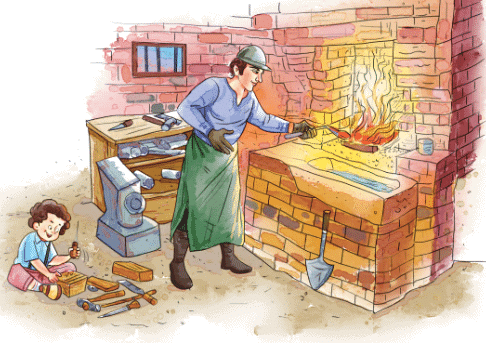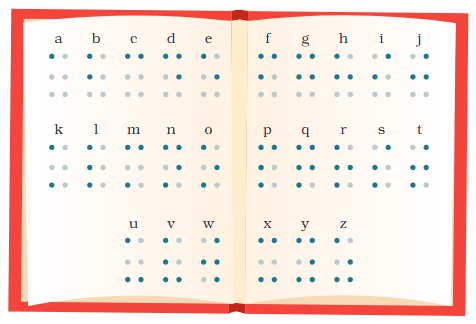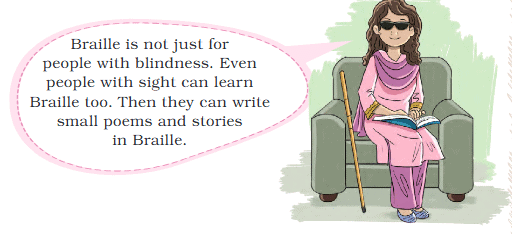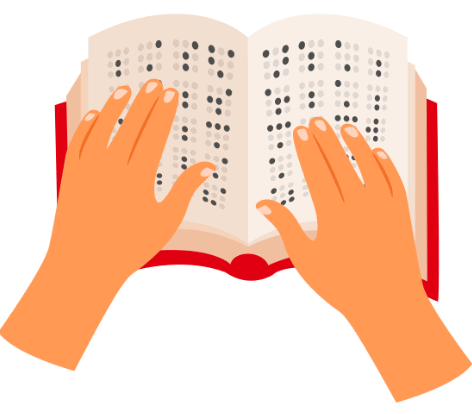Class 4 English Short Answer Questions Chapter 6 Braille
Q1. Who was Louis Braille?
Answer: Louis Braille was a little boy from France who became blind after an accident with a tool when he was three years old.
Q2. How did Louis Braille become blind?
Answer: Louis Braille became blind after a sharp tool pierced his eye when he was playing outside his home.
Q3. What did Louis Braille invent?
Answer: Louis Braille invented the Braille alphabet, which is a system of raised dots that blind people use to read and write.

Q4. Who invented the 'Night Writing' system before Louis Braille?
Answer: Capt. Charles Barbier de la Serre invented the 'Night Writing' system, which Louis Braille later simplified.
Q5. What makes Braille books thicker than regular books?
Answer: Braille books are thicker because the letters are spaced farther apart, so they require more space than regular printed letters.
Q6. How did Louis Braille learn to read and write after losing his sight?
Answer: After Louis Braille lost his sight, he learned to read and write using wood, cloth, or pins arranged in pincushions. He practiced different methods to feel the raised patterns of letters. His determination helped him improve, and later, he simplified the ‘Night Writing’ system to create the Braille alphabet, which helped blind people around the world read and write.
Q7. What was the original purpose of the ‘Night Writing’ system?
Answer: The 'Night Writing' system was invented by Capt. Charles Barbier to help soldiers read messages in the dark without using light. It used raised dots and dashes, allowing soldiers to feel the letters. However, it was too complex, and Louis Braille later simplified it into the Braille alphabet, making it accessible and easier for blind people to read and write.

Q8. Why is Braille an important invention for blind people?
Answer: Braille is an important invention because it provides a way for blind people to read and write. Before Braille, blind individuals had difficulty accessing written content. Braille uses raised dots to represent letters, allowing blind people to read books, letters, and write their own stories. It opened up opportunities for education, communication, and independence for people with visual impairments.
Q9. How did Louis Braille simplify the ‘Night Writing’ system?
Answer: Louis Braille simplified the 'Night Writing' system by reducing the complexity of the raised dots and dashes. He created a system using six dots arranged in a grid, which made it easier for blind people to read and write. This simplified system became the Braille alphabet, which is now used worldwide by blind people to read, write, and communicate.
Q10. What was the significance of the Braille alphabet?
Answer: The Braille alphabet revolutionized the way blind people read and write. It allowed them to access books, education, and written information independently. Before Braille, there were no standardized systems for blind people to read. Louis Braille’s invention opened doors for communication, helping blind people gain knowledge, participate in society, and live more independently.
Q11. How does Braille help both blind and sighted people?
Answer: Braille helps blind people read and write through touch, using raised dots for letters. It allows blind individuals to read books, letters, and other written materials. Interestingly, sighted people can also learn Braille. This helps them write in Braille for blind people, making it easier to communicate and share written content with those who cannot see.

Q12. What materials were used to write the early version of Braille?
Answer: Early versions of Braille were written using materials like wood, cloth, and pins arranged in pincushions. Louis Braille experimented with these materials to create raised dots that could be felt by touch. These simple yet effective tools allowed him to read and write. Later, the Braille alphabet was adapted to more durable materials like paper, making it more practical for widespread use.
Q13. What was the role of the Royal Institute for Young Blind Persons in Louis Braille’s life?
Answer: The Royal Institute for Young Blind Persons in Paris played a crucial role in Louis Braille’s life. It was there that Louis Braille learned to read and write using methods like wooden letters and pins. The institute gave him access to education, which allowed him to develop his skills further and eventually invent the Braille alphabet, which transformed literacy for blind people.

Q14. What challenges did Louis Braille face before inventing Braille?
Answer: Before inventing Braille, Louis Braille faced many challenges due to his blindness. He struggled to read and write using the methods available at the time. He had to experiment with different systems and materials to find an effective way for blind people to read. Despite these challenges, Louis Braille’s determination and creativity led him to invent the Braille alphabet, changing the world for the blind community.
Q15. What is the main message of Louis Braille’s story?
Answer: The main message of Louis Braille’s story is that determination and innovation can overcome challenges. Despite losing his sight at a young age, Louis Braille found a way to read and write through his invention of the Braille alphabet. His story teaches us that creativity, hard work, and a desire to help others can lead to groundbreaking achievements.
|
41 videos|379 docs|39 tests
|
FAQs on Class 4 English Short Answer Questions Chapter 6 Braille
| 1. What is Braille and how is it used by visually impaired individuals? |  |
| 2. How do you learn Braille effectively? |  |
| 3. What materials are commonly used to write in Braille? |  |
| 4. Are there different types of Braille? |  |
| 5. How can technology assist in learning and using Braille? |  |
















